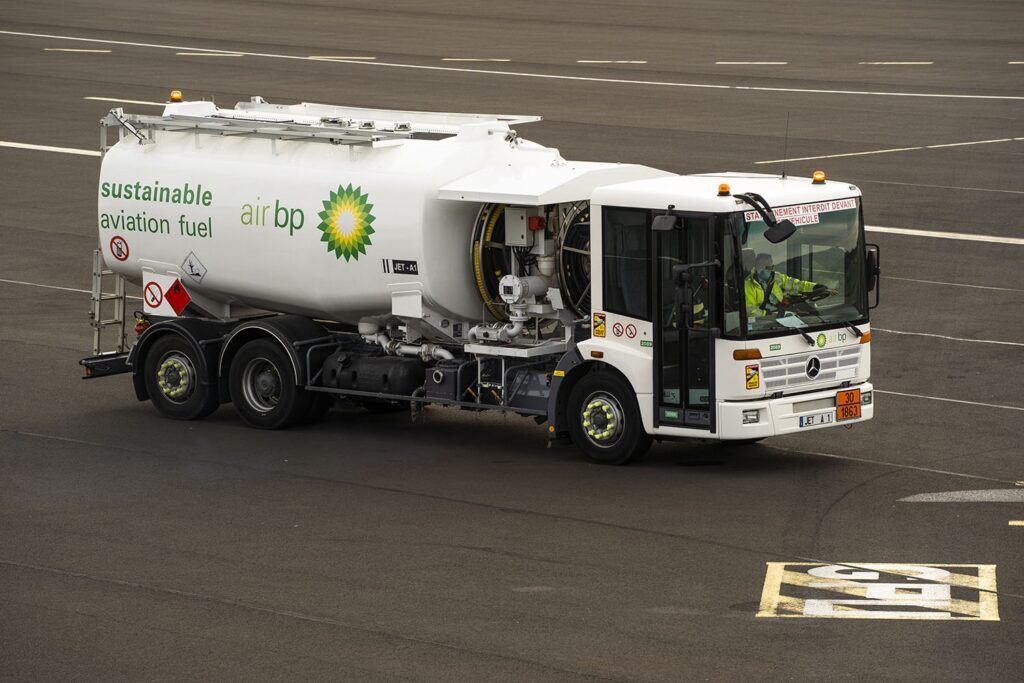
(CLERMONT FERRAND, FRANCE. NOVEMBER 2021.)
Two experts from Air bp discuss the current state of sustainable fuel use in the aviation industry as well as predictions for its future trajectory.
eSAF, a synthetic fuel derived from renewable energy sources, looks to be an increasingly important aspect of achieving the aviation industry’s decarbonization goals—along with using numerous other pathways to produce sustainable aviation fuel (SAF). Aircraft today can incorporate up to 50% eSAF along with conventional fuel, and eSAF can easily be used as a drop-in fuel.
In their Thought Leadership series published this week, Air bp features sustainability director Andreea Moyes, along with bp’s senior advisor for hydrogen and eFuels, Peter Nowobilski, in a discussion about SAF.
SAF is critical for decarbonization, and although it makes up just 1% of the supply of aviation fuel currently available on the market, its commercial use continues to increase worldwide. A report from the Air Transport Action Group about the challenge of decarbonizing the aviation industry stated: “By 2015, the first regular supply of SAF was being delivered to airports and since then a number of new production facilities have been in development or construction. Despite this progress, it is estimated that by 2025, only around 2% of total jet fuel use will be with sustainable aviation fuels.”
Moyes and Nowobilski make the point that the majority of the current SAF supply comes from limited quantities of feedstocks via a pathway of hydrotreated esters and fatty acids (also known as HEFA). Therefore, producing SAF to achieve the aviation industry’s low-carbon goals must use a variety of different pathways. One of these pathways is eSAF—the synthetic fuel that is created from renewable energy sources.

Electric-powered aircraft is currently limited to short-distance journeys in part because of the substantial weight of the batteries used. Current battery cell technology is also geared towards meeting the requirements of automotive applications rather than those of electric aircraft. eVTOLs require extremely fast charging capabilities and high-power cell discharging, which requires the development of battery technology to meet their unique needs.
To take advantage of renewable electricity in operating large aircraft and traveling long distances, the electricity generated from solar, hydro, and wind power has to be converted into a synthetic fuel such as hydrogen. To efficiently use hydrogen as aviation fuel, however, most commercial aircraft flying today would need to undergo a re-design, particularly to the propulsion system and fuel storage, because hydrogen is one-fourth as dense as traditional jet fuel.
“This is where eSAF derived from power-to-liquid (PtL) technology comes in,” write Moyes and Nowobilksi. “Renewable electricity is used to break water into its components of hydrogen and oxygen via an electrolysis process. Carbon dioxide captured from the air, or from biogenic or industrial sources, together with this hydrogen are then converted to carbon monoxide and water through the reverse water gas shift process.”
Additional hydrogen and carbon monoxide are transformed into a wax (a synthetic crude oil) through the use of Fischer-Tropsch (FT) synthesis technology. This wax is then developed into eSAF or other types of fuel. “Legislation currently allows us to use FT technology to blend eSAF by up to 50% with conventional jet fuel. It can be easily stored, transported, and distributed using existing infrastructure,” according to the article.

“A simplified view of which kinds of energy options might be able to contribute to the reduction in CO2 emissions from air transport in which time period. This generally indicates when the technology may be commercially available, but not widespread use throughout the fleet.” (Credit: Air Transport Action Group)
The main barrier to scaling up SAF and eSAF production is cost. It can be eight times more expensive to produce than traditional jet fuel. Considering that eSAF will play a large role in the future of the aviation industry, it’s even more important to invest in developing sustainable fuels.
Moyes and Nowobilksi state, “The good news is there is already legislation in Europe that places the development of eSAF at the forefront of aviation’s sustainability agenda. Germany, for example, has agreed [on] a roadmap which will come into effect in 2026 for the development and use of eSAF for the aviation sector.”